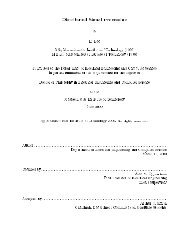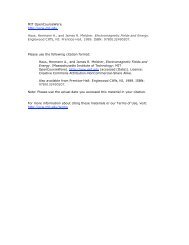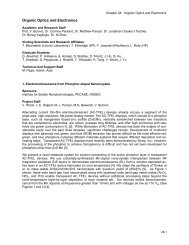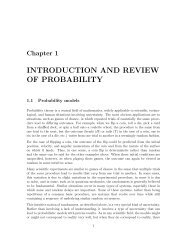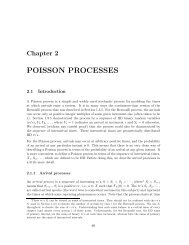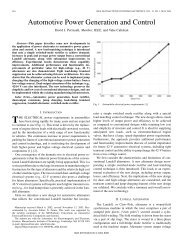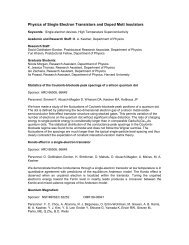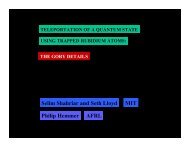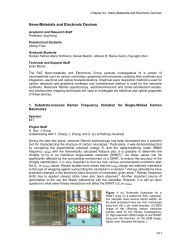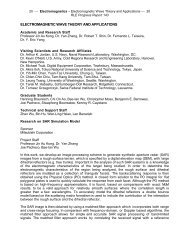RLE Progress Report No - Research Laboratory of Electronics - MIT
RLE Progress Report No - Research Laboratory of Electronics - MIT
RLE Progress Report No - Research Laboratory of Electronics - MIT
Create successful ePaper yourself
Turn your PDF publications into a flip-book with our unique Google optimized e-Paper software.
ps FWHM, coincident in time with the interaction beam, and is focused into the plasma through<br />
an f/4.5 lens. The Thomson scattered light is collected through the full aperture <strong>of</strong> the collection<br />
optic (f/4). The Thomson scattering diagnostic was set up to look only at the forward propagating<br />
EPWs, i.e. those propagating in the same direction as the interaction laser. Although we do not<br />
image the backward propagating EPWs their presence is inferred from the resultant Thomson<br />
spectrum.<br />
Thomson scattering is a resonant process that requires frequency, ω and wave vector, k <br />
matching be satisfied. 5<br />
Frequency and wave vector matching cannot be achieved with arbitrary<br />
probe and collection angles. To calculate the resonance points and thus the probe and collection<br />
angles required we use the usual dispersion relation for an EM wave in a plasma and kinetic<br />
dispersion relations for EPWs and IAWs. The focal ratio <strong>of</strong> the probe and collection optics allows<br />
for a finite range <strong>of</strong> wave vectors (and frequencies for the scattered light) to participate in the<br />
Thomson scattering. The Thomson probe was set up to investigate plasma densities near<br />
n e<br />
/n c<br />
~0.03, where n c<br />
is the critical density. The probe beam was sent in at 50±6.3 degrees and<br />
the scattered light was collected at 63±7.1 degrees, which allowed probing waves parallel to k o<br />
(the SHS beam) from 1.34k o<br />
to 1.76k o<br />
. We calculate that our diagnostic would allow resolution <strong>of</strong><br />
the SRS EPW and up to three subsequent forward propagating LDI cascade steps. Half <strong>of</strong> the<br />
Thomson scattered light was sent to a diagnostic that resolved the wavelength in time and the<br />
other half was sent to a diagnostic that resolved the wavelength versus angle on the collection<br />
optic (i.e. effectively ω vs. k ) integrated over the duration <strong>of</strong> the probe pulse. The latter was<br />
accomplished by imaging the optic plane <strong>of</strong> the collection lens, rather than its focal plane. 6<br />
diagnostic was useful in understanding any structure observed in the time-resolved spectra.<br />
The backscattered SRS spectrum from a particular shot in a regime where LDI is observed is<br />
shown in Figure 2. <strong>No</strong>te that in all spectral images presented here, the wavelength is the<br />
spectrally resolved wavelength <strong>of</strong> the measured light and is related to the radial frequency <strong>of</strong> the<br />
wave by λ = 2πc/ω, where c is the speed <strong>of</strong> light. For this shot the intensity was I≈1.92x10 15<br />
W/cm 2<br />
and the measured SRS reflectivity was R≈3.2%. Thomson scattering <strong>of</strong>f <strong>of</strong> ion acoustic<br />
waves from similar shots indicated an electron temperature <strong>of</strong> T e<br />
≈350±50 eV. The SRS spectrum<br />
has an average center wavelength <strong>of</strong> ~657.4 nm and duration <strong>of</strong> ~154 ps. As a consistency<br />
check, from the SRS data we estimate that the density fluctuation for this shot<br />
2 2 1/ 2<br />
δ =0.0284 exceeds the LDI threshold <strong>of</strong><br />
( n / n)<br />
= [4R<br />
∆k<br />
n n k L<br />
max<br />
/( /<br />
co)<br />
o<br />
]<br />
1/ 2<br />
1/ 2<br />
( δ n / n)<br />
= 4kLλD<br />
( via<br />
/ ωia<br />
) ( vL<br />
/ ω<br />
p<br />
) =0.0117. 7,8 In these equations R max<br />
is the maximum<br />
reflectivity, ∆k is the spectral width <strong>of</strong> the SRS, n is the electron density, k o<br />
and n co<br />
are the wave<br />
number and critical density <strong>of</strong> the incident beam, L is the interaction length, k L<br />
is the wave vector<br />
<strong>of</strong> the SRS generated Langmuir wave, λ D<br />
is the electron Debye length, (ν ia<br />
/ω ia<br />
) is the ratio <strong>of</strong> the<br />
IAW damping to its real frequency, and (ν L<br />
/ω p<br />
) is the ratio <strong>of</strong> the Langmuir wave damping to the<br />
plasma frequency. The SRS spectrum clearly shows curvature towards shorter wavelengths over<br />
the duration <strong>of</strong> the laser pulse and there is an abrupt change in the curvature at time t ~60 ps.<br />
From the SRS spectrum we can infer that the plasma density decreases from n e<br />
/n c<br />
~0.03195 at<br />
early times to n e<br />
/n c<br />
~0.03105 at late times. For these conditions the expected separation between<br />
the SRS EPW and the first LDI cascade with a forward propagating EPW would be ~10.3 Å.<br />
This<br />
5 J. Sheffield, Plasma Scattering <strong>of</strong> Electromagnetic Radiation (New York: Academic Press, 1975).<br />
6 D. M. Villeneuve, H. A. Baldis, and J. E. Bernard, “Supression <strong>of</strong> Stimulated Raman Scattering by Seeding the<br />
Stimulated Brillouin Scattering in a Laser-Produced Plasma,” Phys. Rev. Lett. 59(14): 1585-1588 (1987).<br />
7 R. K. Kirkwood et al., “Effect <strong>of</strong> Ion-Wave Damping on Stimulated Raman Scattering in High-Z Laser-Produced<br />
Plasmas,” Phys. Rev. Lett. 77(13): 2706-2709 (1996).<br />
8 S. J. Karttunen, “Ion fluctuation effects on the two-plasmon decay and stimulated Raman scattering,” Phys. Rev. A<br />
23(4): 2006-2010 (1981).



